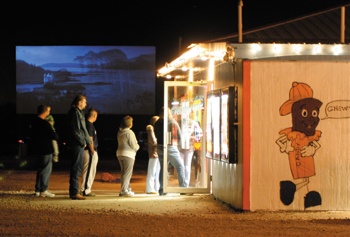In the 1950s, more than 4,000 drive-ins dotted the American landscape. And Texas, of course, had the most, nearly 400. But times changed. Owners retired. Suburbs encroached, and land once relegated to the outer edges of towns increased in value and was sold to developers.
Happily, there is a minor resurgence of drive-in operators. Some too young to remember drive-ins during their heyday are reconditioning their hometown monoliths. Others are starting from scratch.
These revitalized or newly constructed drive-ins are finding an appreciative audience. People are once again enjoying the freedoms they cannot exercise in the mall cineplex. No need for hushed whispers. Cell phone users can converse without fear of reprisal. Smokers can smoke, and at many venues, animal lovers can bring their pets. RVs, SUVs, 18-wheelers, motorcycles, boats—even buses filled with tourists—all are welcome. Classic cars often congregate around nostalgic movies such as “Grease” or “American Graffiti.”
Unlike in the past, today’s selection of movies is often first-run. Digital stereo sound broadcasts from little local drive-in stations and is played over car radios. And many Texas drive-ins operate year-round—at least on the weekends.
With its two-for-the-price-of-one, double-feature entertainment and reasonably priced food, a night at the drive-in is much less expensive than at the mall cinema. Small, pajama-clad children are often admitted for free and can be tucked in back seats and covered with a blanket when sleepy—eliminating the expense of a baby-sitter. Teenagers can pile into the back of a pickup. Couples can snuggle.
John Earl Morrow is one of the new drive-in entrepreneurs. The owner and operator of Morrow Drilling in the Texas Panhandle used to indulge his childhood memories of movies shared with his family at Clarendon’s long-deserted Sandell Drive-In.
On Labor Day in 2002 he reopened the Sandell—unaware at the time that the original owner had opened on the same holiday in 1955. Today the venue retains the popular pink-and-black color combination from the 1950s. Morrow hopes to someday register the Sandell, which is restored almost to its original condition, on the roster of historic places.
Martin Murray of Albemarle, North Carolina, had a similar dream. In 1986, he began collecting theater equipment. “He was bringing projectors home and setting them on my kitchen table,” his wife, Marsha, laments. “I’d ask, ‘Why?’ and complain that he needed to do something with the mess.”
He did. The Murrays saved their paychecks, and in 2001, the family of seven moved from North Carolina to Ennis. There, from the ground up, they built their four-screen Galaxy Drive-In Theatre.
They opened the Galaxy in 2004 in the middle of the winter, thinking the colder weather would limit attendance and allow them time to perfect the running of the new business. They were wrong. From the beginning, the venture was an enormous success, the couple says.
Now on weekends, cars frequently choke the Garrett exit on Interstate 45 before entering the four lanes of ticket booths. Although already capable of accommodating about 1,500 cars with four screens, numbers five, six, and seven are in the works. And since prohibitively high insurance rates make the traditional drive-in playground unfeasible, the Murrays say they are purchasing carnival rides for their own corner amusement park.
They also have plans for an 18-hole golf course.
While owning such an entertainment complex might sound like a life of fun and games, the realities can be sobering. “I get e-mails from people interested in getting into the business,” Marsha says. “I tell them we work 365 nights a year—no vacations—no holidays. Hours are unreal. Last night, after making salads and cotton candy, I finally got home at 7 a.m. You give up a lot of personal and family time to make other people happy. Usually, I never hear another word from them again.”
Still, many drive-in dreamers remain undaunted. Adam Hulin is a friend of the Murrays. He, too, left North Carolina—Asheboro—to reopen the Tower Drive-In Theatre in Rule, population, 708. Since the 1970s, when the indoor theater closed, the Tower is Haskell County’s “last (and only) picture show.”
More than just a place to watch a movie, Rule’s drive-in is a social gathering spot—especially for teenagers. With the closest multiplex some 60 miles away in Abilene, the Tower pulls from several nearby counties. As testament to the drive-in’s importance in the community, area residents raised the money to build the current metal screen replacement when the original wooden one blew down in 1998. Austin’s venerable Alamo Drafthouse Cinema, named “the No. 1 theater doing it right” by Entertainment Weekly, once bused cinemaphiles 500 miles round trip for a night of nonstop movies at the Tower.
Some area residents come for food and conversation alone, leaving before the movie ever starts. To Hulin’s surprise, a snowcone drenched in pickle juice is a favorite treat.
At the Sky-Vue Drive-In Theatre in Lamesa, where Buddy Holly once performed atop the projector room roof, owners Sam and Carolyn Kirkland feature a Pucker Powder machine and the Chihuahua Sandwich—a patented item invented in 1951. The recipe includes chili, grated raw cabbage and homemade pimento cheese, all atop two fried corn tortillas (onions and jalapeño optional).
It’s a far cry from the glory days of the 1950s, but there are more than a handful of active theaters. Not only are the venues back in the black, but they’re thriving in full Technicolor. Both owners and patrons alike can once again gather under star-studded skies to enjoy family, food, film and fun at the base of the big screens.
——————–
Carol Wissmann is a freelance writer based in Gig Harbor, Washington.


